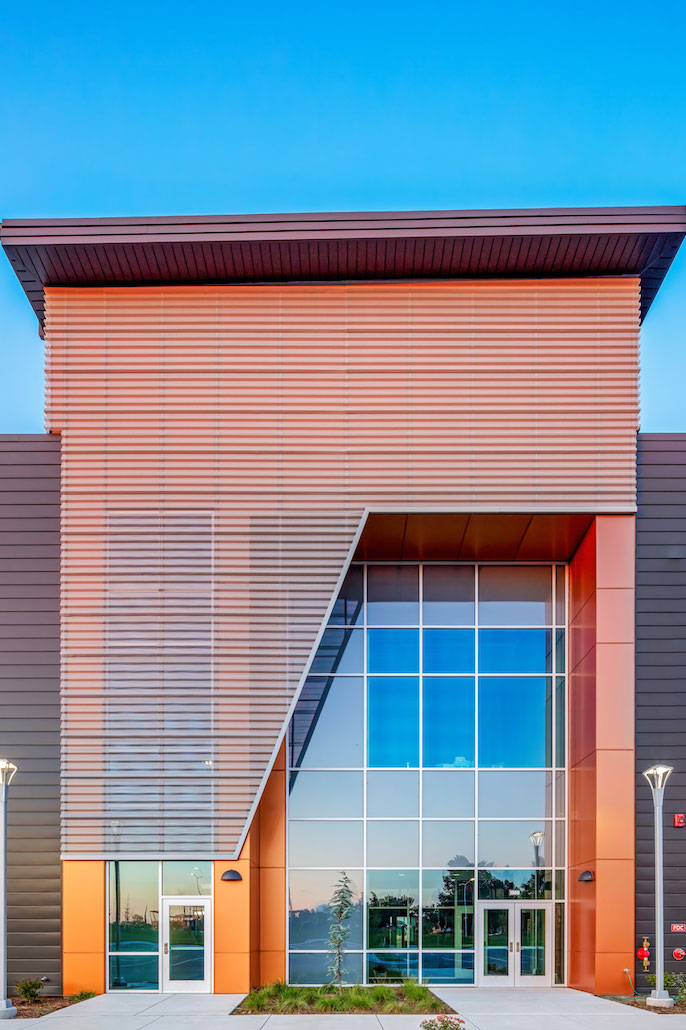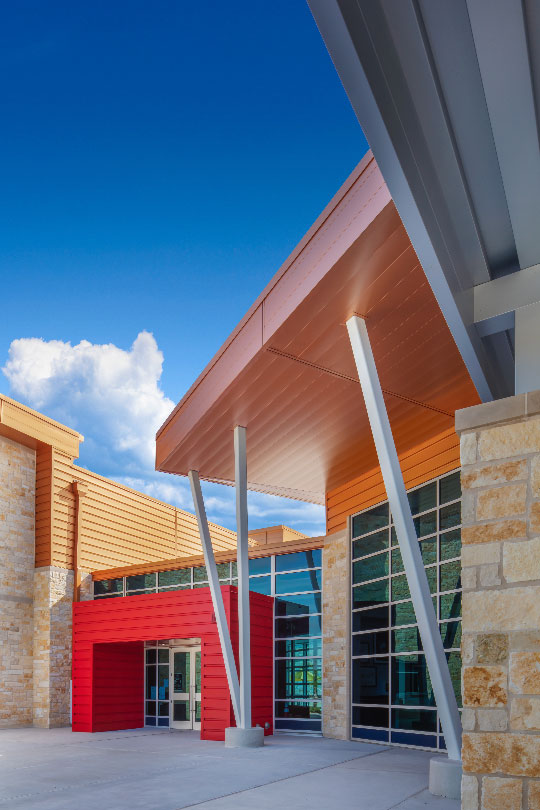Story at a glance
- Metal wall panels and solutions from PAC-CLAD | Petersen are changing the design game.
- HOK modernized the Footprint Center, home to the Phoenix Suns, with a metal facade that changes color in the sun.
Metal facades that change color with the sun, perforated metal, uniquely shaped panels—metal can seemingly do anything, and that’s part of why designers love it.
“It’s definitely one of the materials I’ll use in any project,” says Devin Norton, senior project designer for HOK based in San Francisco.
We talked to global design, architecture, engineering, and planning firm HOK as well as a leading manufacturer of metal panels Petersen (which makes the PAC-CLAD brand) about how they design with metal, its benefits, and how the material is changing.
Limitless Design Flexibility
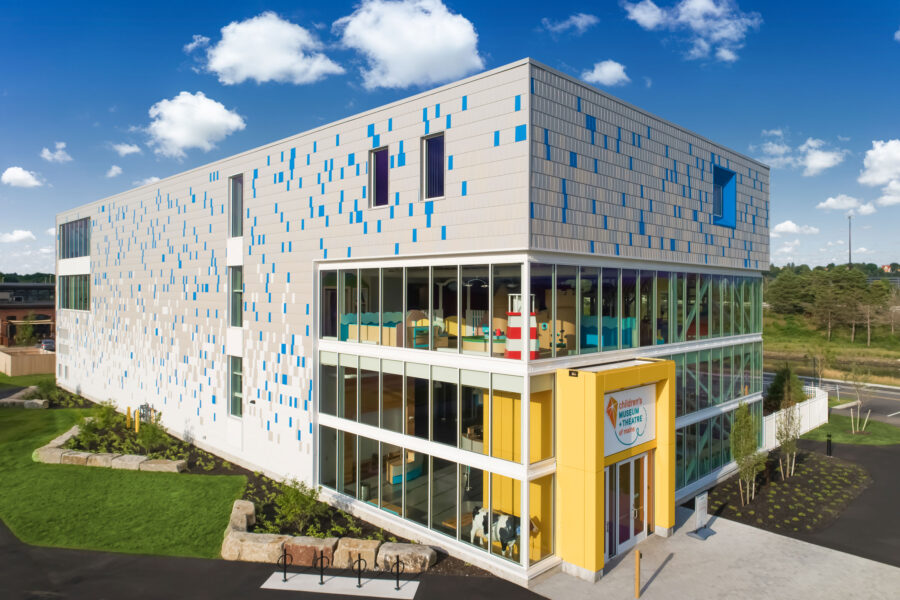
The Children’s Museum and Theatre of Maine features PAC-CLAD Precision Series TS Tile. Photo by Matt Horton
“You look at any type of project that has been done over the years—some of the most complex projects out there—and metal panels are used,” Norton says. “It can be bent, and it can be molded and panelized to any shape for the most part.” Metal walls, metal roofing, metal tile systems, perforated aluminum—the options are endless across most projects.
Norton says architects can clad virtually any building to bring their vision to life—something you can’t often do with glass. “Glass has certain restrictions. A metal panel has a lot more flexibility. Just like you can’t do certain things with concrete. A metal panel can take any type of shape.”
Norton and the HOK team used a metal panel facade that moves in the wind to bring life to the Footprint Center, home of the Phoenix Suns NBA team. The 298,000-square-foot stadium project is eye-catching to onlookers, covered in metal flaps, and Norton says the look was easy to achieve across a large area as compared to, say, using full metal panels or another alternative. “The building has this kinetic energy as it transitions throughout the day because the flaps move with the wind.” The metal uses a special color-shifting paint that is especially dynamic, he says, and the changing light and wind cause the building to appear in shades of deep red, yellow, and even white. “It’s a representation of wind through metal.”
A metal panel is a very malleable material.
When buildings like the Footprint Center were initially designed in the ’90s they were essentially “big, dumb boxes,” Norton says. “As the architecture developed in the community and in Phoenix we looked for a way to re-energize those facades. This was a very cost-effective way to use metal panels that are mass produced on a unitized system. We could ultimately create something that is both dynamic as well as efficient—a new facade for the entire building.”
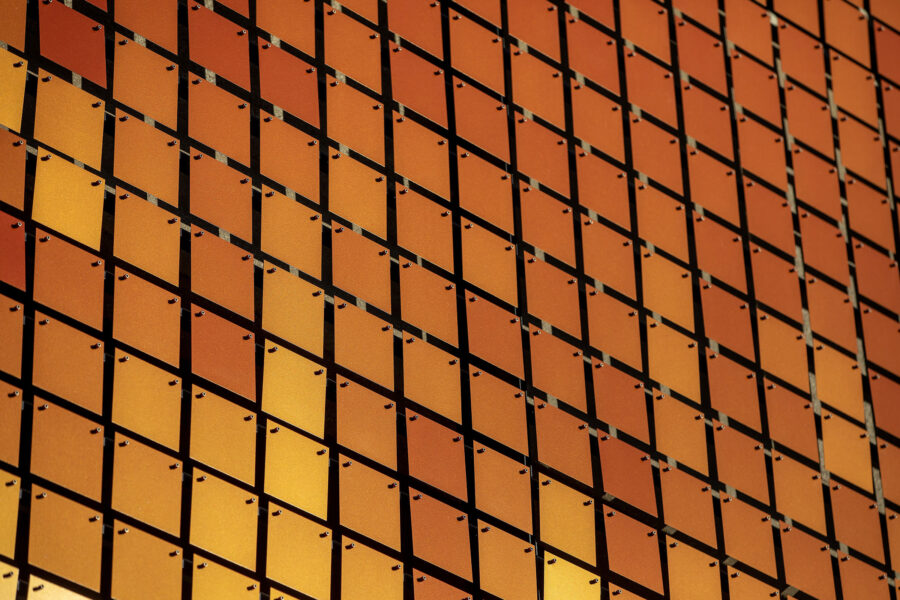
The Footprint Center in Phoenix emphasizes sustainable design strategies, including a metal panel facade. Photo by Christy Radecic
Whether you want a simple facade or a dynamic moving exterior like at the Phoenix stadium, metal can make it happen, Norton says. “A metal panel is a very malleable material.”
Standing seam panels are standard for roofs, while for walls you have options like hidden or exposed fasteners as well as perforated panels or panels that are dimpled. “It’s a material you can get a lot of different looks out of.”
Metal walls have taken off and are Petersen’s largest area of growth, according to Tom Becka, a regional sales manager at the company, overseeing 13 states. “New construction, renovations, rehab—whatever it is there’s really no limit to how these can be used.”
Some of the most popular PAC-CLAD products are the aluminum wall panels and flat sheet. Perforated aluminum can provide a contrasting look with any non-perforated metal to create visual interest on any project. Architects can specify perforated aluminum to diffuse light, air, or sound (it’s showing up more in acoustic interior projects, too), or simply for aesthetics. Typical applications include equipment screens, partitions, sign panels, parking decks, guards, and enclosures. You can easily mix and match metal profiles and colors, too, Becka says.
Sustainability and Longevity
- The Wichita State University Partnership Building 7 features PAC-CLAD the Reveal Panel and 7.2 Panel in Graphite and Cityscape. Photo courtesy of Petersen
- The Lone Star College East Aldine Satellite Center in Houston features PAC-CLAD Profiles Highline S1 and Flush panels in Copper Penny and Cardinal Red. Photo courtesy of Petersen
Specifying PAC-CLAD metal cladding can help projects earn LEED points. Metal panels can be 100% recycled at the end of their life cycle of 30 to 50 years, Becka says, further decreasing the amount of building materials thrown in a landfill.
Metal panels also help to block UV rays, thanks to resins in the Kynar coatings that are applied to PAC-CLAD products. Buildings clad with Kynar-coated products can reduce their carbon footprint by reflecting the sun’s energy to keep interiors cool during warm weather. PAC-CLAD panels are manufactured using coatings with high solar reflectivity numbers and qualities.
Their perforated metal is available in countless combinations of hole sizes, spacing, and open-space percentages, and the mills manufacturing these products are on a journey to be zero carbon.
PAC-CLAD | Petersen’s nationwide facilities also help keep the cost of shipping down with shorter transportation times.
Enduring Durability
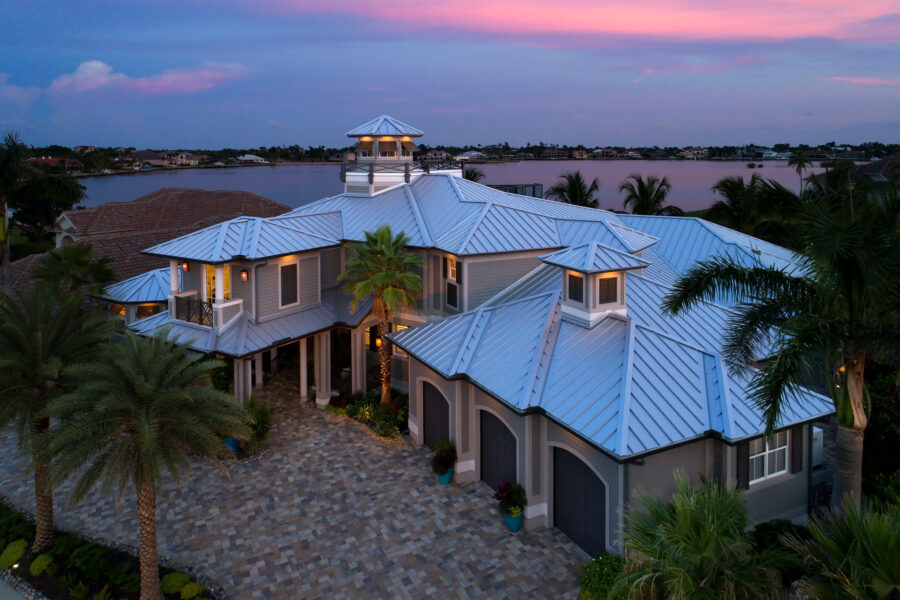
A Marco Island residence features Snap-Clad in Cityscape. Photo courtesy of Petersen
Metal is also very durable. Petersen’s metal products are manufactured to adapt to a world of climate change. They’re denser than concrete or wood, and their metal wall and roofing systems stand up to harsh environments like pollution and extreme weather. Their finishes are made with Kynar 500 70% PVDF high-performance fluoropolymer resin, allowing them to retain their color and gloss year after year—so much so that they come with a 30-year, non-prorated finish warranty.
One private residence on Robins Bay, designed by Marco Island firm WHL Architecture, features a PAC-CLAD roof from Petersen that’s intended to stand up to the harsh coastal weather. Ten-thousand square feet of Snap-Clad .032-gauge panels featuring a Cityscape finish were installed on the home. The standing seam panels feature a continuous interlock to ensure weather tightness and finishes are guaranteed not to fade—even with ongoing exposure to sun and salt air.
Once in the design-develop stage, Becka suggests architects reach out to the structural engineer to get their opinion on wind loads as well as how close the project is to salt or brackish water. Then, together with Petersen, they can select the system most appropriate for where the building is located.
“You can use single-skin metal on a variety of buildings,” Becka says. “It depends on the conditions, and we have systems that can accommodate snow loads and wind loads better than others.”
Brilliant Color and Finishes
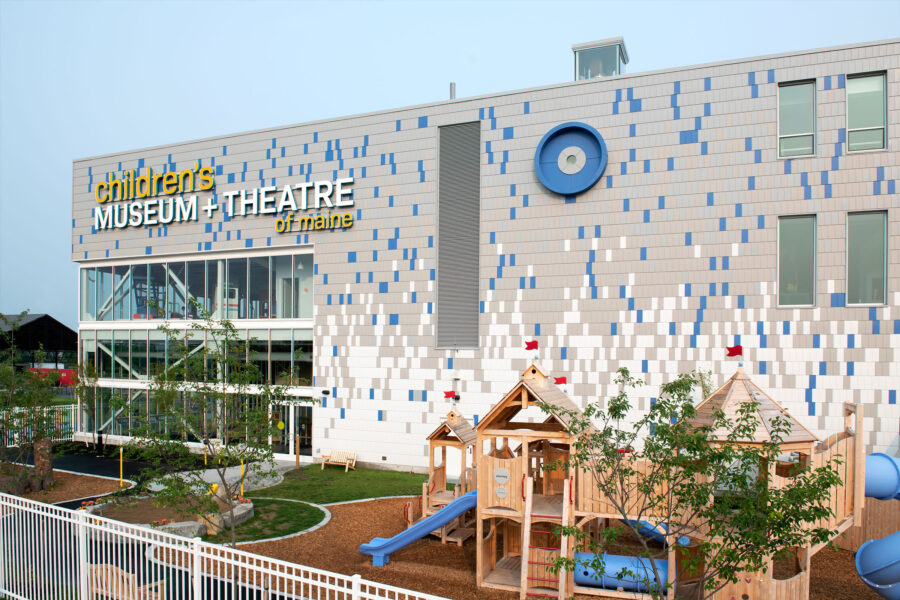
A children’s museum in Maine used a variety of colors of aluminum from Petersen, inspired by the neighboring bay. Photo courtesy of Petersen
PAC-CLAD architectural metal is offered in 46 standard colors, including rich metallics and weathered metal finishes. Architects and designers can also choose from 16 wood grain finishes as well as 16 ore finishes that replicate the look of natural metal patina, all with the durability of steel or aluminum. “You can mix and match profiles and colors on the same elevation to really jazz it up,” Becka says. One of their panel systems can even curve with the building.
Flush and Reveal wall panels provide a flush (or flat) appearance, while the Modular AL panel system, launched in 2023, invites designers to create unique cassette-style metal cladding surfaces using panels of various sizes, depths, and colors. The Modular AL metal wall panel and siding system is made of 100% recycled aluminum with concealed fasteners and a 30-year non-prorated finish warranty.
Thirty-five of PAC-CLAD’s wide range of colors are rated by the Cool Roof Rating Council, as they reflect heat. Most colors meet LEED requirements, too. “Just by putting our metals on the walls or roof you will help reduce the heat gain inside the building and therefore reduce the strain on the HVAC system,” Becka says.
A children’s museum in Portland, Maine used a variety of colors of aluminum from Petersen, inspired by the neighboring bay. Approximately 15,600 square feet of PAC-CLAD Precision Series Tiles were used on the project. The tiles were specified in .032-gauge aluminum to stand up to the waterfront location, in finishes of Stone White, Granite, Cityscape, and Berkshire Blue. A two-person crew installed all the tiles at the impressive rate of, on average, 500 panels a day in the field. “It’s gorgeous,” Becka says. “I can’t wait to bring my grandkids there.”


